|
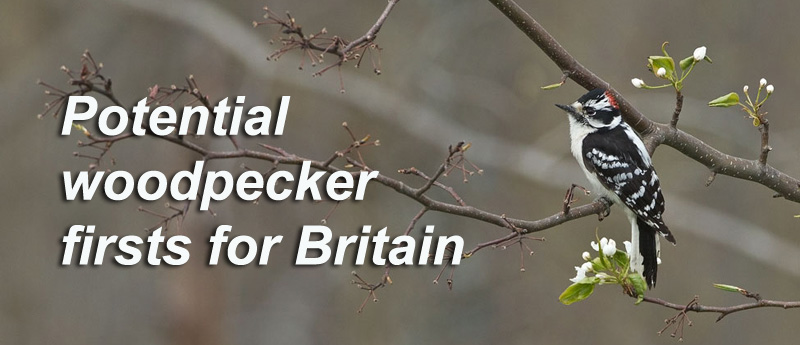
Downy Woodpecker, copyright Mark S. Szantyr, from the surfbirds galleries
Potential woodpecker firsts for Britain
Author: Ross Ahmed, Ecologist
Twitter: @RossAhmed
Woodpeckers may not strike birders as the most likely vagrants, but there are reasons to believe that further species will be added to the British list. This article discusses some of the more likely additions to the British list based on migration, range and population.
|
|
|
Introduction
Woodpeckers Picidae are a large family of birds spread around the world consisting of around 230 species. Whilst a relatively small number of woodpeckers have been recorded in Britain, there is potential for several additional species to occur in the future. Woodpeckers may not strike birders as the most likely vagrants, but there are reasons to believe that further species will be added to the British list. Northern Great Spotted Woodpecker (Dendrocopos major major) is irruptive and regularly makes it across the North Sea to Britain (Garner 2014) and Lesser Spotted Woodpecker has recently been added to the Scottish list and was thought to be of the Scandinavian race minor (Fray 2013). Black Woodpecker is a hotly anticipated species in Britain and indeed has been claimed on many occasions and the Yellow-bellied Sapsucker record in Britain shows that, by whatever means, woodpeckers can find their way to Britain across large expanses of water. This article discusses some of the more likely additions to the British list based on migration, range and population.
Eurasian Three-toed Woodpecker
Distribution and population
The species has a huge distribution spanning a large part of the Palearctic land mass from northern Europe across to the Pacific coast of Asia. In Europe, its distribution closely follows the distribution of Norway Spruce (Gorman 2004). It is generally uncommon in many parts of its range with an estimated population in western Europe of around 58,000 pairs; for context, the population of Great Spotted Woodpecker in Europe is almost 4 million pairs (del Hoyo et al. 2020).
Migration and vagrancy
Northern Eurasian populations occasionally erupt and juveniles can appear far from their natal areas. Siberian populations also regularly migrate long distances (del Hoyo et al. 2020) and birds seen in Scandinavia far from traditional breeding areas are thought to involve Russian birds (Gorman 2004). In autumn 1988 during an invasion of Great Spotted Woodpecker into western Europe, a male Eurasian Three-toed Woodpecker was reported to have come in off the sea on 11th October on the island of Sylt, Germany before spending a short period in the dunes. However, the record was not submitted for assessment (Dierschke 2004). There are also a small number of records from Denmark indicating the potential for the species to occur outside the species' normal range (Bruun 2020). The potential German record possibly indicates that the species is most likely to occur during influxes of Northern Great Spotted Woodpecker into Britain. Such influxes have occurred in the Northern Isles and have mirrored irruptions in Finland (Garner 2014).
Identification
Nearly as large as Great Spotted Woodpecker. Shows largely black upperparts contrasting with paler underparts. Distinctive stripy head pattern with a yellow crown in males. Appearance varies across its range and eight subspecies are recognised by the IOC (Gill et al. 2020).

Three-toed Woodpecker, copyright Zoltan Baczo - Sakertours, from the surfbirds galleries
Calls
Black Woodpecker is a hotly anticipated species in Britain and indeed has been claimed
on many occasions and the Yellow-bellied Sapsucker record shows that woodpeckers
can find their way across large expanses of water.
Middle Spotted Woodpecker
Distribution and population
Its range lies almost entirely within the Western Palearctic and covers much of Europe, but is generally absent from Scandinavia and Iberia. It is fairly common within its range and has recently returned as a breeder to the Netherlands with up to 375 breeding pairs in the country by 2012. However, this has been countered by decline in other parts of its range, such as in Sweden where it last bred in 1980 (Winkler et al. 2020a)

Figure 1. Middle Spotted Woodpecker distribution map (BirdLife International & Handbook of the Birds of the World 2020)
Migration and vagrancy
It is a resident species but short-distance dispersal can lead to extralimital records (Winkler et al. 2020a). There are numerous recent records in Denmark and Estonia, while it has also occurred recently in Finland and Sweden (Bruun 2020).
Identification
Slightly smaller than Great Spotted Woodpecker with a gentle impression created by the rounded head and short bill. The largely white face, extensive red crown and streaked underparts are reminiscent of male Lesser Spotted Woodpecker, but unlike that species it shows a large white shoulder patch. The species is possibly most easily detected using its call and the call is also a useful identification clue: a series of Great Spotted Woodpecker-type calls repeated at a fast pace, as given in the sound recording below.
 |
|
Middle-spotted Woodpecker, copyright Alan Lewis, from the surfbirds galleries
|
Calls
Downy Woodpecker
Distribution and population
Downy Woodpecker is a North American species with an extensive range that covers a large portion of the continent. Its range extends south to the Gulf Coast and north to the tree line in Canada and Alaska. The species is common within its range and 13 million individuals have recently been estimated to be present in the United States and Canada. Its breeding densities reach their highest in the eastern half of North America, particularly in the mid-Atlantic states (Jackson & Ouellet 2020).
 |
| Figure 2. Downy Woodpecker distribution map (from The Birds of The World, birdsoftheworld.org, published by the Cornell Lab of Ornithology) |
Migration and vagrancy
The evidence suggests that the species does not undertake regular migration but does occasionally disperse over long distances (Jackson & Ouellet 2020). Robbins (1980) estimated the relative likelihood of autumn transatlantic vagrancy by North American passerines and near-passerines to Europe. Downy Woodpecker was listed as a potential vagrant by Robbins, although of the species he assessed, Downy Woodpecker was in the lowest probability group. However, a number of species included within this group, such as Mourning Dove, Blackburnian Warbler and Indigo Bunting, have since occurred in Britain. The species has yet to be recorded in the Western Palearctic, although there are two historical claims from Britain, neither of which were found to be acceptable records (Prys-Jones et al. 2020).
Identification
The species shows a resemblance to Lesser Spotted Woodpecker, especially as the two species are a similar size. However, the head of Downy Woodpecker gives a stripy appearance and male Downy shows much less red on the head than male Lesser Spotted Woodpecker.
|
|
|
Downy Woodpecker, copyright Glyn Sellors, from the surfbirds galleries
|
Calls
Hairy Woodpecker
Distribution and population
Similarly extensive as Downy Woodpecker, being present across most of North America, although compared to Downy its range protrudes further south into Central America. While still a common species, it is less numerous than Downy Woodpecker: 8.5 million individuals have recently been estimated in the United States and Canada. Its population increased by 54% in the latter half of the 20th century (Jackson et al. 2020).
 |
Figure 3. Hairy Woodpecker distribution map (from The Birds of The World, birdsoftheworld.org, published by the Cornell Lab of Ornithology)
|
Migration and vagrancy
The species is largely non-migratory throughout its range although does undertake irregular dispersal movements. As with Downy Woodpecker, Robbins (1980) considered Hairy Woodpecker to be a potential future vagrant to Europe, although concluded the probability of the species occurring on this side of the Atlantic relatively low. A single individual was recorded by Alan Durand during ship voyages across the North Atlantic between 1961-65 (Durand 1972).
Identification
Hairy Woodpecker is sufficiently similar in appearance to Downy Woodpecker that the two species are often confused. However Hairy is larger with a proportionately longer and heavier bill that appears to be as long or longer than the length of the head. In eastern North America, the red nape patch of Hairy is often split into two sections whereas the red nape patch in Downy is undivided (Jackson et al. 2020). In a British context, the longer bill of Hairy Woodpecker makes the species a little reminiscent of Great Spotted Woodpecker, although clearly differs from that species due to a more striking head pattern and the lack of a white shoulder patch.
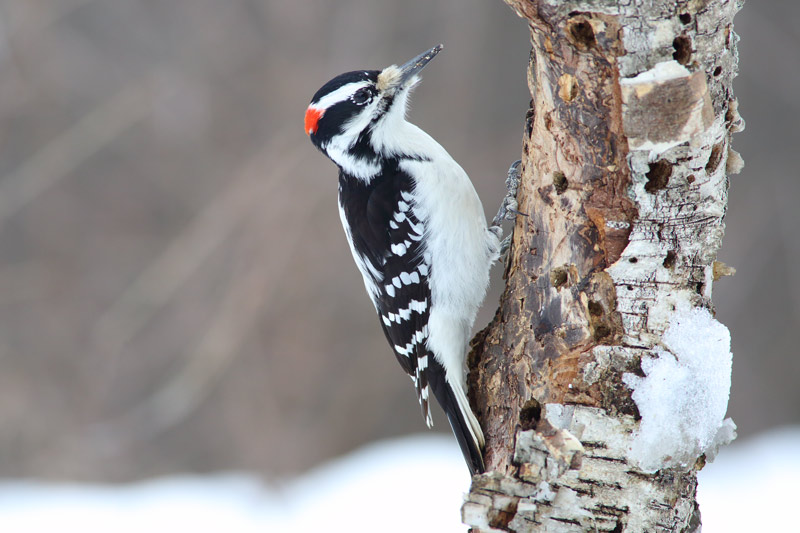 |
|
Hairy Woodpecker, copyright Glyn Sellors, from the surfbirds galleries
|
Calls
Syrian Woodpecker
Distribution and population
Much of the species' distribution lies within the Western Palearctic. Its range includes south-east Europe, Turkey, the Levant region, Iran and Iraq. It is a common species in most of its range with approximately 170,000 pairs estimated to be present in Europe (Winkler et al. 2020b).
 |
Figure 4. Syrian Woodpecker distribution map (BirdLife International & Handbook of the Birds of the World 2020)
|
Migration and vagrancy
Whilst Syrian Woodpecker does not undertake regular migration, it can disperse over long distances and has recently occurred in a number of extralimital countries. The species has expanded its range considerably since the late 19th century. Formerly, it was restricted to the eastern Mediterranean but has since spread to central Europe, Ukraine and European Russia (Winkler et al. 2020b). It was recorded for the first time in Lithuania in 2002, Kazakhstan in 2010 (Wassink et al. 2011) and Germany in 2015 (Bruun 2020).
Identification
Syrian Woodpecker is very similar in appearance to Great Spotted Woodpecker and its detection in Britain would provide a considerable challenge if it was ever to occur. Syrian shows a whiter face than Great Spotted owing to more white and less black on the forehead and the absence of a black joining the malar stripe to the nape. Syrian also shows a longer bill, less white on the outer tail feathers, a larger red nape patch and a pink rather than red vent compared to Great Spotted (Svensson et al. 2010; Winkler et al. 2020b).
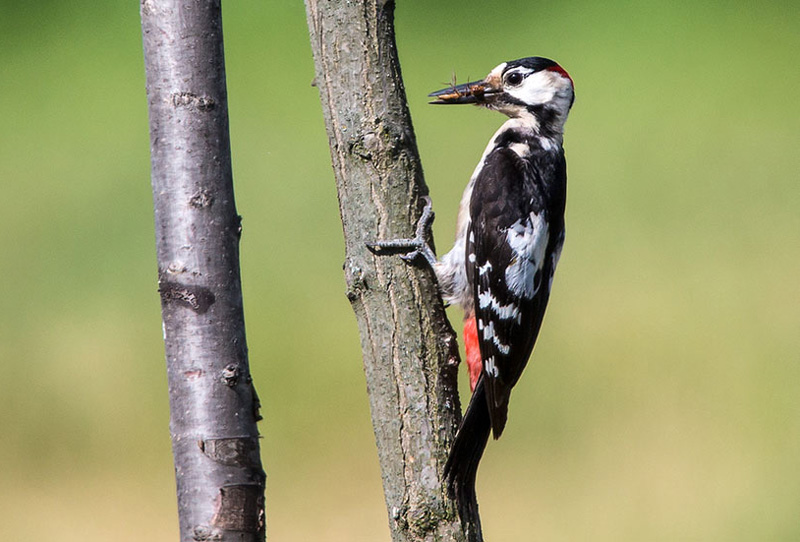 |
|
Syrian Woodpecker, copyright Ron Marshall, from the surfbirds galleries
|
Calls
Northern Flicker
Distribution and population
Northern Flicker is a North American species with a large range that covers much of the continent. It is a common species with an estimated population of nearly 10 million individuals in the United States and Canada. Abundance during the breeding season peaks in the western United States, south-west Canada and the Great Lakes region. However, the species is undergoing long-term declines in much of its range (Wiebe & Moore 2020).
 |
Figure 5. Northern Flicker distribution map (from The Birds of The World, birdsoftheworld.org, published by the Cornell Lab of Ornithology)
|
Migration and vagrancy
Northern populations of the race that occurs in eastern North America are highly migratory, moving into south-eastern United States in late autumn and returning north in early spring. This migratory tendency was one of the reasons that led Robbins (1980) to classify the species as a likely vagrant to Europe. A total of at least 20 individuals were recorded by Alan Durand during ship voyages across the North Atlantic between 1961-65 (Durand 1972). Within the Western Palearctic, the species has now occurred three times in the Azores and once in Denmark (Bruun 2020). There are further records in Ireland in 1962 and Scotland in 1981 that were both accepted to category D due to the likelihood of ship assistance.
Identification
Northern Flicker looks sufficiently different to any regular British species that it is unlikely to evade detection if seen well. Its tendency to forage on the ground (Wiebe & Moore 2020) may further increase the likelihood of detection. Although Northern Flicker is very similar in appearance to Gilded Flicker, the latter is an unlikely vagrant to Britain, being resident in a relatively small area in western North America.
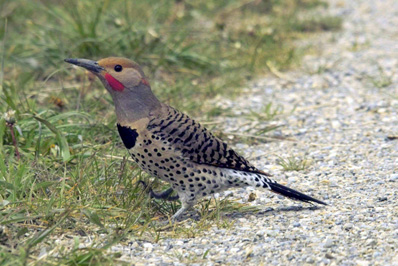 |
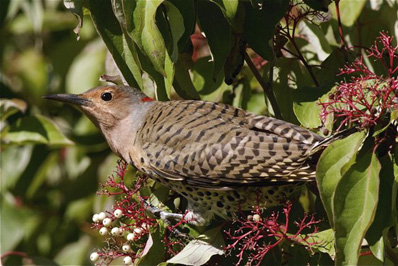 |
|
Northern Flicker (red-shafted form), copyright Derek Moore, from the surfbirds galleries
|
Northern Flicker, copyright Clara Coen, from the surfbirds galleries
|
Calls
Black Woodpecker
Distribution and population
Black Woodpecker is another species with a huge Palearctic range, extending from western Europe across to the Far East. However, it is most common towards the western end of its range and uncommon towards the east. Densities are low fairly and the European population, including European Russia, is estimated at about 549,000 pairs. It is increasing in the west of its range and since about 1970 has colonised large areas in which it was formerly absent (Winkler & Christie 2020). A recent population estimate in France put the population at 2,000 pairs with both the population and range increasing within the country (Gorman 1998).
 |
Figure 6. Black Woodpecker distribution map (BirdLife International & Handbook of the Birds of the World 2020)
|
Migration and vagrancy
It is resident in much of its range but northern populations are partly migratory and juveniles show some dispersal behaviour (Winkler & Christie 2020). Black Woodpecker occurs in France less than 50km from the Kent coast, ringing recoveries have shown that juveniles can disperse across large distances and it occurs on various Palearctic islands. It seems strange that the species has not yet been recorded in Britain, and indeed, the species has been claimed on numerous occasions. Fitter (1992) reviewed previous claims of the species in Britain and found an incredible 82 records. All of the claims have either not been submitted, were specimen records of unknown provenance or were found to be unacceptable due to concerns surrounding identification. Black Woodpecker is an eagerly awaited addition to the British list and is likely to be very popular with British birders should an individual linger in an accessible location.
Identification
Black Woodpecker should present few identification problems, being wholly black except for a red crown and is crow-like in both size and coloration. Its flight lacks the undulations of other woodpeckers and its flight action is not dissimilar to Eurasian Jay, further strengthening its crow-like appearance.
|
|
|
Black Woodpecker, copyright Glyn Sellors, from the surfbirds galleries
|
Calls
Summary
It may be decades before any woodpeckers are added to the British list, but given Britain's reputation for attracting vagrants, it could well be sooner. A Northern Flicker on a barren Scottish island in October should be startlingly obvious, but a Syrian Woodpecker in a more obscure mainland location will require a combination of awareness of its ID features and serendipity. The charisma of woodpeckers will ensure that any firsts for Britain will be a popular draw to birders, should they linger in an accessible location. The sight of a vagrant woodpecker on a tree-less island clinging to an unorthodox structure would no doubt live long in the minds of birders fortunate enough to see it.
References
BirdLife International & Handbook of the Birds of the World. 2020. Bird species distribution maps of the world. Version 2020.1. [Retrieved from http://datazone.birdlife.org/species/requestdis on 12th February 2021].
Bruun, M. 2020. Bird News. Tarsiger. [Retrieved from http://www.tarsiger.com on 23rd November 2020].
del Hoyo, J., Collar, N. & Christie, D. A. 2020. Eurasian Three-toed Woodpecker (Picoides tridactylus), version 1.0., in Billerman, S. M., Keeney, B. K., Rodewald, P. G. & Schulenberg, T. S. (ed.) Birds of the World. Cornell Lab of Ornithology, Ithaca, NY, USA. [Retrieved from https://birdsoftheworld.org/bow/species/ettwoo1/cur/introduction?login#conserv on 15th December 2020].
Dierschke, J. 2004. Three-toed Woodpecker: a potential vagrant? Birding World 17: 299.
Durand, A. L. 1972. Landbirds over the North Atlantic: unpublished records 1961-65 and thoughts a decade later. British Birds 65: 428–442.
Fitter, R. 1992. From the Archives: The Black Woodpecker, a lost British bird. Birding World 5: 75–77.
Fray, R. M. 2013. Lesser Spotted Woodpecker, Scalloway, Shetland, October 2012 - the first record for Scotland. Scottish Birds 33: 78–81.
Garner, M. 2014. British and Northern Great Spotted Woodpeckers, in Garner, M. (ed.) Birding Frontiers Challenge Series: Autumn: 56–59. Birding Frontiers.
Gill, F., Donsker, D. & Rasmussen, P. 2020. IOC World Bird List (v10.2). [Retrieved from https://www.worldbirdnames.org/new/ on 12th December 2020].
Gorman, G. 1998. The spread of Black Woodpecker in Europe – will it reach Britain next? Birding World 11: 390–395.
Gorman, G. 2004. Three-toed Woodpecker – species, races and clines. Birding World 17: 209–220.
Jackson, J. A. & Ouellet, H. R. 2020. Downy Woodpecker (Dryobates pubescens), version 1.0, in Rodewald, P. G. (ed.) Birds of the World. Cornell Lab of Ornithology, Ithaca, NY, USA. [Retrieved from https://birdsoftheworld.org/bow/species/dowwoo/cur/introduction?login on 22nd December 2020].
Jackson, J. A., Ouellet, H. R. & Jackson, B. J. 2020. Hairy Woodpecker (Dryobates villosus), version 1.0, in Rodewald, P. G. (ed.) Birds of the World. Cornell Lab of Ornithology, Ithaca, NY, USA. [Retrieved from https://birdsoftheworld.org/bow/species/haiwoo/cur/introduction on 20th December 2020].
Prŷs-Jones, R., van Grouw, H.& Schofield, P. 2020. A review of records of Downy Woodpecker in Britain. British Birds 113: 211–216.
Robbins, C. S. 1980. Predictions of future Nearctic landbird vagrants to Europe. British Birds 73: 448–457.
Svensson, L., Mullarney, K., Zetterström, D. & Grant, P. J. 2010. Collins Bird Guide. Collins, London.
Wassink, A., Ahmed, R., Busuttil, S. & Salemgareev, A. 2011. Oriental Plover, Franklin’s Gull, Syrian Woodpecker and Masked Shrike new to Kazakhstan. Dutch Birding 33: 239–244.
Wiebe, K. L. & Moore, W. S. 2020. Northern Flicker (Colaptes auratus), version 1.0, in Rodewald, P. G. (ed.) Birds of the World. Cornell Lab of Ornithology, Ithaca, NY, USA. [Retrieved from https://birdsoftheworld.org/bow/species/norfli/cur/introduction on 23rd December 2020].
Winkler, H. & Christie, D. A. 2020. Black Woodpecker (Dryocopus martius), version 1.0, in del Hoyo, J., Elliott, A., Sargatal, J., Christie, D. A. & de Juana, E. (ed.) Birds of the World. Cornell Lab of Ornithology, Ithaca, NY, USA. [Retrieved from https://birdsoftheworld.org/bow/species/blawoo1/cur/introduction on 28th December 2020].
Winkler, H., Christie, D. A., Kirwan, G. M. & de Juana, E. 2020a. Middle Spotted Woodpecker (Dendrocoptes medius), version 1.0, in del Hoyo, J., Elliott, A., Sargatal, J., Christie, D. A. & de Juana, E. (ed.) Birds of the World. Cornell Lab of Ornithology, Ithaca, NY, USA. [Retrieved from https://birdsoftheworld.org/bow/species/miswoo1/cur/introduction on 27th December 2020].
Winkler, H., Christie, D. A. & de Juana, E. 2020b. Syrian Woodpecker (Dendrocopos syriacus), version 1.0, in del Hoyo, J., Elliott, A., Sargatal, J., Christie, D. A. & de Juana, E. (ed.) Birds of the World. Cornell Lab of Ornithology, Ithaca, NY, USA. [Retrieved from https://birdsoftheworld.org/bow/species/syrwoo1/cur/introduction on 27th December 2020].
|

